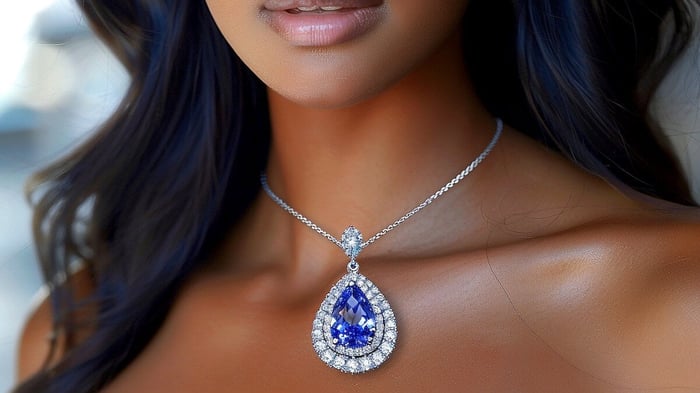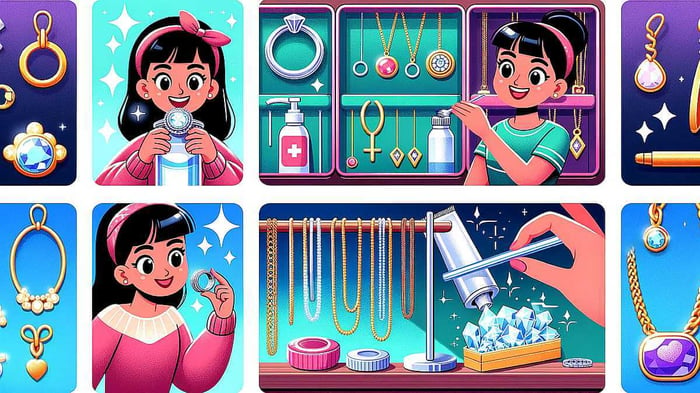Jewellery from the Edwardian era, which lasted from 1901 to 1910, is well-known for its sophisticated and delicate design. The Art Nouveau movement and Queen Alexandra's preferences had a significant influence on Edwardian jewellery. During this period, there was a distinct shift towards lighter and more airy motifs.
Craftsmen used platinum, allowing for finer and more intricate designs compared to the heavier styles of the Victorian era. Key features of Edwardian jewellery include filigree work, millegrain details, and lace-like patterns, often adorned with diamonds and other precious stones to showcase elegance and wealth.
Common motifs included bows, garlands, and floral designs, symbolising femininity and romance. Exploring this era further unveils the intricate craftsmanship and lasting impact on modern jewellery design.
Highlights of Edwardian Jewellery
Edwardian jewellery, dating from 1901 to 1910, is renowned for its light, refined designs that often feature platinum and intricate lace-like patterns. Both the Art Nouveau movement and Queen Alexandra's sense of style had a significant influence on jewellery during this time period. The pieces frequently showcase pearls, diamonds, and motifs such as bows and floral designs.
The widespread use of platinum in Edwardian jewellery enabled artisans to achieve intricate craftsmanship. Techniques like millegrain and filigree were commonly employed, adding to the jewellery's refined appearance. Diamonds were central to this period's jewellery, symbolising wealth and sophistication. Various popular cuts and settings were used to maximise the stones' sparkle.
The lasting legacy of Edwardian jewellery continues to influence contemporary designs, focusing on understated beauty and complex artistry.
€2.842,95
Las joyas vintage son la manera perfecta de añadir ese toque especial a tu atuendo. Este impresionante collar ha sido elaborado a mano en oro blanco macizo de 18 quilates y engastado con 2,60 quilates de zafiro azul. El hermoso… read moreCollar vintage con zafiro azul de 2,60 ct y diamantes de 0,90 ct en oro blanco
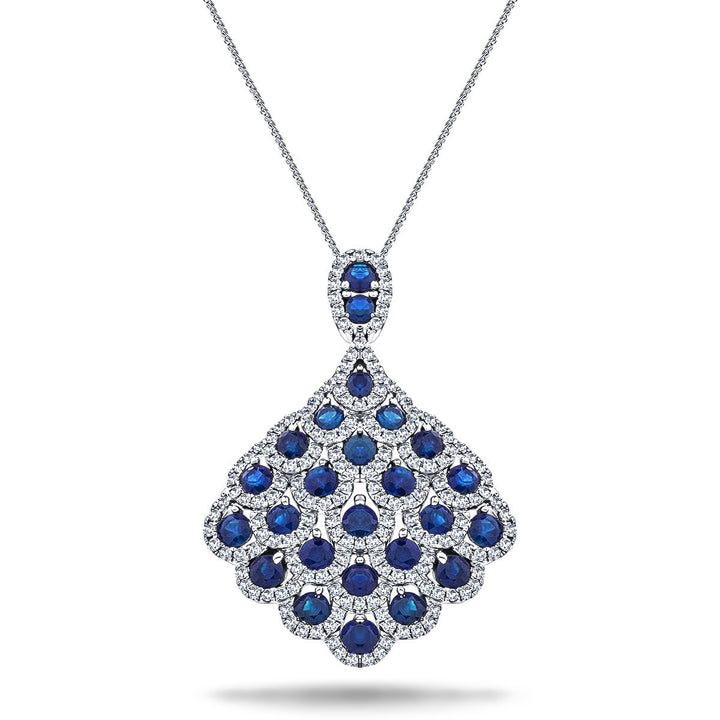
Brief Introduction to the Edwardian Era (1901-1910)
The Edwardian period, from 1901 to 1910, represents a distinct chapter in the history of jewellery, renowned for its elegant and sophisticated designs.
This article explores the distinctive characteristics that define Edwardian jewellery, illuminating its historical significance and the enduring allure of its craftsmanship.
Significance of Edwardian jewellery in historical context
From 1901 to 1910, the Edwardian period, named after King Edward VII of England, marked a significant evolution in jewellery design and aesthetics. This era transitioned from the opulence of the Victorian period to the precipice of World War I, reflecting broader cultural shifts.
Jewellery designs became lighter and more feminine, heavily influenced by the Art Nouveau movement. Fashion trends of the time favoured intricate, lacy designs, made possible through the extensive use of platinum. Symbolism and artistry were key, with many pieces featuring geometric and classical motifs inspired by ancient art.
Diamonds and precious gemstones were commonly used, embodying the refined aesthetic and timeless elegance characteristic of the Edwardian age.
€20.156,95
Una colección impecable de tres diamantes cortados a mano perfectamente colocados y engastados de forma segura en un centelleante platino brinda un brillo resplandeciente que no se puede perder. Un anillo para lucir en fiestas o exhibir sutilmente en reuniones… read moreAnillo Tres Piedras Diamante 3.00ct Calidad G/SI en Platino
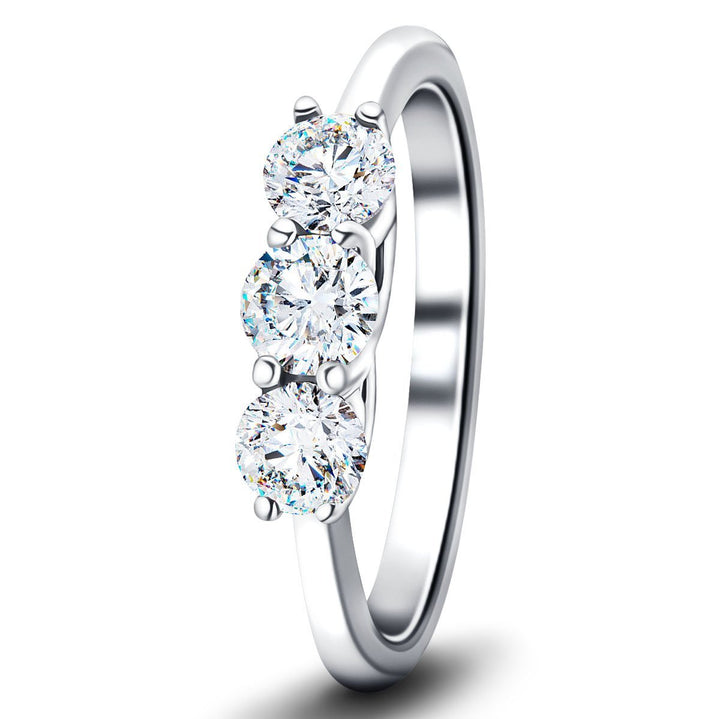
The key characteristics and elegance of Edwardian jewellery
The period's design sophistication is evident in its delicate, lacy patterns, made possible by advancements in platinum craftsmanship. These designs often featured motifs such as bows, garlands, and intricate florals, showcasing influences from both the Art Nouveau movement and classical antiquity.
Edwardian jewellery is celebrated for its feminine sophistication, aligning with the era's fashion ethos that emphasized grace and refinement. Techniques like millegrain and filigree were used to add depth and texture, enhancing the overall aesthetic and highlighting the period's dedication to detailed and high-quality craftsmanship.
Historical Context of the Edwardian Era

The Edwardian Period, defined by King Edward VII's reign, was a time of notable cultural and social changes, which significantly impacted the aesthetics and craftsmanship of the era.
Queen Alexandra, a key fashion influencer, greatly influenced jewellery trends highlighting elegance and sophistication.
This era also saw a seamless transition in style from the elaborate designs of the Victorian period to the more graceful and delicate motifs characteristic of Edwardian jewellery.
Overview of the social and cultural climate during King Edward VII's reign
During the reign of King Edward VII, society underwent significant changes in elegance, technology, and international relations, collectively shaping the era's cultural and aesthetic preferences.
This period was notable for social reforms and cultural shifts that reverberated through various social strata, influencing public attitudes and norms.
With a focus on enhancing international relations, Edward VII's reign also witnessed remarkable technological advancements that modernised daily life and bolstered the status of the elite, resulting in more lavish designs in art and jewellery.
This era celebrated the blend of tradition and innovation, paving the way for a new age of artistic expression deeply embedded in the social fabric of the time.
Influence of Queen Alexandra on fashion and jewellery trends
Queen Alexandra's significant influence on Edwardian fashion brought about notable changes in jewellery trends, highlighting a preference for high necklines, elegant silhouettes, and luxurious accessories. Her impact went beyond fashion, representing a broader cultural shift within the elite circles of society.
Aristocratic women embraced her style choices, such as the popularisation of choker necklaces, intricate tiaras, and elaborate brooches, setting a new standard of elegance and sophistication. Queen Alexandra's love for pearls and diamonds particularly shaped the jewellery designs of the period, resulting in delicate and opulent pieces.
Her contributions to fashion and jewellery remain influential, cementing her legacy as a pivotal figure in the evolution of modern style.
The transition from Victorian to Edwardian styles
Marking a significant evolution in style, Edwardian jewellery emerged as a lighter, more refined alternative to the ornate and robust designs typical of the Victorian period. This aesthetic shift reflects the broader cultural changes of the time, emphasising elegance and subtlety in both art and fashion.
Design Evolution: The transition from heavy, dark motifs to lighter, airier designs saw the use of platinum for delicate, lacy settings, offering a stark contrast to the Victorian style.
Artistic Influences: Edwardian jewellery incorporated elements of Art Nouveau, which emphasised natural forms and flowing lines and added a touch of whimsy and grace.
Aesthetic Transformation: The bold and complex compositions of the Victorian era gave way to simpler, more ethereal designs. Diamonds and fine gemstones became central, highlighting the period's preference for understated beauty.
Motifs and Symbolism: Geometric and classical motifs became popular, blending ancient artistic elements with the contemporary tastes of the Edwardian period.
This progression mirrors changes in social attitudes and a deeper connection to beauty and artistry during the Edwardian era.
Key Characteristics of Edwardian Jewellery

Edwardian jewellery is renowned for its distinctive features, emphasising lightness, elegance, and femininity. These distinguish it from the more lavish styles of earlier periods.
The shift from gold to platinum during this era facilitated the creation of more intricate and delicate designs, thanks to advancements in metalworking techniques.
These pieces often feature airy, openwork patterns, giving them an ethereal and graceful look that continues to appeal to collectors and fashion enthusiasts today.
Description of the main features of Edwardian jewellery
Edwardian jewellery is famous for its intricate, lace-like designs that beautifully showcase diamonds and other precious stones. The characteristics of Edwardian jewellery highlight a remarkable level of aesthetic sophistication and a strong connection to the craftsmanship techniques of the era. These characteristics include:
Craftsmanship Techniques: Edwardian jewellery often features millegrain, filigree, and piercing work. These techniques create detailed and delicate patterns that add a sense of lightness and intricacy to the designs.
Design Motifs: Common motifs include bows, garlands, and floral patterns, reflecting the period's appreciation for beauty and elegance.
Material Choices: Platinum was the preferred metal due to its strength and ability to create fine yet durable settings.
Handmade Quality: Each piece was meticulously crafted by hand, ensuring unique details and exceptional craftsmanship. This appeals to those who value individuality and artisanal heritage.
Emphasis on lightness, elegance, and femininity
Building upon these intricate design features, Edwardian jewellery is particularly noted for its focus on lightness, elegance, and femininity. Delicate craftsmanship was highly valued during this period, enabling jewellers to create pieces that conveyed a refined aesthetic sensibility, enhancing the wearer's grace.
Central to the designs were feminine elements like bows, garlands, and floral motifs, which communicated a sense of softness and romantic elegance. These motifs were crafted with such intricate detail that they appeared almost ethereal, perfectly capturing the era's ideal of genteel beauty.
Techniques such as filigree and millegrain added texture and depth without overwhelming the jewellery's inherent delicacy. Each piece was a testament to skilled artisanship, inviting admiration and a sense of belonging among its wearers.
Prevalent use of platinum over gold
Why Platinum Outshone Gold During the Edwardian Era
In the Edwardian period, platinum became the metal of choice over gold. This preference was not just a fleeting trend but a reflection of evolving tastes and technological advancements. Here are the primary reasons for this shift:
Strength and Durability
Platinum's robustness made it ideal for creating delicate yet long-lasting jewellery. Its strength allowed jewellers to craft finer pieces that could withstand daily wear without losing their form or beauty.
Intricate Designs
A hallmark of Edwardian jewellery was the ability to create detailed filigree work. Platinum's malleability and strength enabled artisans to produce intricate, lace-like, elegant, sophisticated patterns.
Enhanced Brilliance
Platinum's natural white sheen provided a perfect backdrop for diamonds and other gemstones. Unlike gold, which can sometimes tint stones, platinum enhanced their sparkle and brilliance, making the gems appear even more dazzling.
Technological Advancements
Introducing new tools and techniques, such as the oxyacetylene torch, played a significant role in the transition to platinum. These innovations allowed jewellers to work with the metal more easily, facilitating the creation of more complex and refined designs.
€6.606,95
Este hermoso anillo de compromiso es la manera perfecta de mantener las cosas especiales. Una opción simple pero elegante, es el complemento perfecto para cualquier atuendo. Un estilo clásico con una impresionante piedra central, este anillo es perfecto para cualquier… read moreAnillo de compromiso de diamantes con montura de hombro certificada de 1,20 ct G/SI en platino

The Rise of Platinum

The Emergence of Platinum in Edwardian Jewellery
The transition to platinum in Edwardian jewellery represented a notable advance in both design and craftsmanship. This metal's exceptional strength and resilience enabled jewellers to create more intricate and delicate patterns, enhancing the overall beauty of the pieces.
Platinum's ability to highlight the sparkle of diamonds and other gemstones significantly increased the aesthetic appeal of the jewellery. A key development in this era was the introduction of the oxyacetylene torch in the early 20th century, which allowed jewellers to work with platinum more effectively, opening up new possibilities for creative expression in fine jewellery.
Historical background on the use of platinum in jewellery
The introduction of platinum in Edwardian jewellery transformed its design, creating detailed and delicate pieces characteristic of the era. Platinum revitalised jewellery aesthetics, fostering a connection among enthusiasts who value both traditional craftsmanship and contemporary designs.
1. Platinum's Revival: Initially gaining popularity in the early 1900s, platinum became a symbol of luxury and timeless elegance.
2. Modern Designs: Today's designers draw inspiration from Edwardian styles, blending classic elements with modern techniques.
3. Sustainable Craftsmanship: Emphasising responsible sourcing, many jewellers now use recycled platinum, appealing to eco-conscious consumers.
4. Community and Appreciation: Collectors and fans of Edwardian jewellery find a sense of community through their shared admiration for the period's distinctive style and platinum's unique qualities.
Advantages of platinum: strength, durability, and ability to hold intricate designs
The emergence of platinum in Edwardian jewellery, known for its exceptional strength and durability, revolutionised the creation of intricate and delicate designs. This remarkable metal offered unparalleled robustness, allowing jewellers to craft elaborate, lace-like patterns that became synonymous with Edwardian sophistication.
The introduction of the oxyacetylene torch in 1901 enabled craftsmen to manipulate platinum in innovative ways. This facilitated intricate filigree work that demanded precision and a delicate touch. Platinum's capacity to preserve even the most intricate designs without compromising the overall delicacy of the piece signalled a new chapter in jewellery production.
This era seamlessly blended strength and beauty, elevating the allure of Edwardian aesthetics.
Examples of notable Edwardian platinum jewellery pieces
During King Edward VII's reign, several iconic pieces of platinum jewellery were crafted, including diamond tiaras, garland necklaces, and filigree brooches. These pieces epitomised the elegance and craftsmanship of the Edwardian era.
Elegant Tiaras: These tiaras showcased intricate filigree work adorned with sparkling diamonds. They represented royal sophistication and became symbols of high society.
Delicate Necklaces: Inspired by garland motifs, these necklaces combined the strength of platinum with delicate, flowing designs, adding to the allure of Edwardian fashion.
Filigree Brooches: The intricate filigree on these brooches demonstrated the exceptional skill of Edwardian jewellers, making each piece a unique work of art.
Garland-Inspired Bracelets: These bracelets featured garland designs and radiant diamonds, seamlessly blending elegance and charm in a circle of platinum.
The Sparkle of Diamonds
In Edwardian jewellery, diamonds held significant importance, serving not only as symbols of wealth and sophistication but also enhancing the visual allure of the pieces.
This era saw the emergence of distinctive diamond cuts, such as European and mine cuts. These styles were essential in accentuating the elaborate platinum settings that were characteristic of the period.
The combination of these cuts and settings perfectly showcased the Edwardian dedication to elegance and the technological advancements that enabled such precise and detailed craftsmanship.
The role of diamonds in Edwardian jewellery
Diamonds were central to Edwardian jewellery, adding unparalleled sparkle and elegance to the period's intricate designs. Let's explore how diamonds featured prominently in Edwardian jewellery:
1. Symbol of Wealth and Love: Diamonds were a clear indicator of wealth and status during the Edwardian era. They also symbolised purity and love, aligning with the social norms of the time.
2. Advancements in Diamond Cutting: The period saw significant improvements in diamond cutting techniques, which enabled more precise and elaborate designs, highlighting the exceptional craftsmanship of Edwardian jewellers.
3. Exquisite Craftsmanship: Skilled jewellers set diamonds in delicate, lace-like platinum settings, utilising platinum's strength to showcase the gems' brilliance.
4. Opulence and Elegance: The use of diamonds underscored the era's affinity for luxury, making each piece a statement of refined elegance.
Popular diamond cuts and settings of the period
The popularity of Edwardian jewellery can be largely attributed to the prominent diamond cuts and prominent settings during the period. The era's diamond shapes were meticulously designed, featuring the rose cut, old mine cut, and single cut, which beautifully complemented the intricate metalwork.
Advances in faceting techniques, driven by DeBeers, allowed diamonds to display remarkable brilliance and clarity. These cutting innovations highlighted the dazzling designs characteristic of Edwardian rings. Setting styles, such as delicate millegrain edges and knife-edge settings, further enhanced the sparkle of each stone.
These elements came together to create stunning Edwardian jewellery, where each piece reflected the artisanal craftsmanship and elegance of its time.
Significance of diamonds as symbols of wealth and sophistication
Why Diamonds Were Highly Prized in Edwardian Jewellery: A Reflection of Wealth and Status
In the Edwardian era, diamonds held a unique position in society, far beyond their role as mere adornments. They were imbued with profound cultural meaning and served as a clear indicator of one's social standing. Here's why diamonds were so esteemed:
Diamond symbolism
Diamonds symbolised purity and invincibility, sending a message of timeless beauty and strength. Their clarity and durability made them perfect emblems of eternal elegance.
Wealth representation
Due to their rarity and considerable cost, diamonds were unmistakable signs of wealth. Wearing diamond jewellery was a public declaration of financial success and high social rank.
Fashion trends
Diamonds led fashion trends, marking the wearer as someone both stylish and affluent. They were often the centrepiece of the era's most fashionable designs, showcasing the latest in jewellery artistry.
Sophistication portrayal
Intricate, lace-like diamond designs reflected high sophistication and meticulous craftsmanship. These pieces embodied the Edwardian values of refinement and grace, highlighting the wearer's appreciation for fine detail and elegance.
Intricate Filigree Designs
The art of Edwardian filigree jewellery
In Edwardian jewellery, filigree work stands as a testament to exceptional craftsmanship. Intricate patterns made of fine metal threads are expertly woven, frequently drawing inspiration from lace and fabric's refined textures. These designs play with light and shadow, creating a visual depth that is both captivating and elegant.
A prime example of this meticulous artistry can be found in the renowned Cartier brooches. These pieces vividly showcase the precision and creativity of Edwardian artisans, making them timeless treasures in the world of jewellery.
Explanation of filigree work and its techniques
Filigree work is a meticulous and elegant jewellery-making technique that employs finely twisted and bent metal wires to create ornate, lace-like designs characteristic of Edwardian pieces. This practice showcases the intricate craftsmanship and skill of artisans who excel in metal wirework, weaving together delicate threads of precious metals.
Selection of Metal
This technique is typically executed in platinum or white gold, chosen for their strength and ability to be finely worked.
Twisting Techniques
Metal wires are carefully twisted into fine strands, providing a scaffold for further enhancements.
Soldering
The twisted wires are then soldered at points of contact, ensuring the structural integrity of the delicate design.
Adding Details
Floral motifs and geometric patterns are often incorporated, requiring precise placement and attachment of supplementary elements.
This technique highlights the precision and dedication inherent in Edwardian jewellery-making.
€502,95
¡Le encantará este anillo de racimo de diamantes con su diseño floral cuando lo deslice en su dedo! La cabeza del anillo se verá impresionante en su dedo con su diámetro de 15,0 mm. El anillo tiene un total de… read moreAnillo Floral Cluster de Diamantes 3.00ct Look Calidad G/SI en Oro Blanco 9k

The influence of lace and fabric patterns on filigree designs
Edwardian jewellery often drew from the intricate and airy patterns of lace and fabric, significantly shaping filigree designs. These lace-inspired filigree elements were more than just decorative; they captured the elegance and lightness of the era's style.
Modern adaptations of these designs continue to embrace this delicacy, blending vintage filigree styles with contemporary desires for uniqueness and personal expression. While filigree techniques have evolved over time, they still retain the essence of their historical roots by incorporating fabric patterns that echo the grandeur of the past.
These modern designs link tradition and modernity, allowing jewellery lovers to appreciate historical craftsmanship while enjoying fresh and individual pieces.
'Jewellery is a way of keeping memories alive,' notes designer Jane Andrews. 'By integrating historical patterns into modern pieces, we offer wearers a tangible connection to the past.'
Showcasing notable examples of filigree in Edwardian jewellery
Drawing on the historical charm of lace-inspired patterns, several notable examples of filigree in Edwardian jewellery beautifully exemplify the era's skill in intricate design.
Platinum pendants
These pendants highlight filigree artistry with delicate, lace-like patterns framing sparkling gemstones. The combination of platinum and intricate design creates an ethereal yet timeless beauty.
Brooches with floral motifs
Brooches of this period often feature elaborate filigree work that forms a delicate, elegant canvas. Diamonds accentuate each petal, offering a glimpse into the refined aesthetic cherished during the Edwardian era.
Scrollwork rings
Rings with geometric and floral scrollwork in filigree showcase a lightweight yet ornate structure. This meticulous craftsmanship is a testament to the skill of Edwardian artisans.
Gem-encrusted bracelets
These bracelets combine intricate filigree with lavish gemstones, creating an enchanting interplay of light and form. They capture the quintessential charm of Edwardian jewellery, blending complexity with elegance.
Popular Edwardian Motifs and Themes in Jewellery

During the Edwardian period, jewellery designs prominently featured motifs such as bows, garlands, and floral patterns. These elements were chosen not just for their aesthetic appeal but also because they symbolised the era's commitment to beauty and elegance.
Such designs were more than mere decoration; they reflected the societal values and artistic tastes of the time. The use of nature-inspired themes further highlighted the period's preference for harmonious and refined aesthetics, making Edwardian jewellery exceptionally graceful and sophisticated.
Common motifs: bows, garlands, floral patterns, and nature-inspired designs
Delicate motifs such as bows, garlands, floral patterns, and nature-inspired designs are hallmarks of Edwardian jewellery's refined and feminine aesthetic. These elements enhance the pieces' beauty and connect wearers to a storied past, invoking a sense of belonging to a graceful heritage.
1. Bows: Symbolising femininity and grace, bows in Edwardian jewellery add an air of sophistication through their elegant designs.
2. Garlands: Representing abundance and beauty, garlands are crafted with intricate craftsmanship, encircling pieces with elegance.
3. Floral Patterns: Intricately designed blossoms and vines offer a romantic and ethereal touch, deeply rooted in nature-inspired motifs.
4. Nature-Inspired Designs: Leaves and flowers connect wearers to nature, enriching each piece's historical context and feminine aesthetic.
€337,95
Cuando se ponga este anillo de racimo de diamantes en su dedo, adorará su diseño floral. Con un diámetro de 9,30 mm, la cabeza del anillo lucirá espectacular en su dedo. ¡El anillo tiene diamantes de calidad G/SI con un… read moreAnillo Floral Cluster de Diamantes 1.00ct Look Calidad G/SI en Oro Blanco 9k

Symbolic meanings behind these motifs
The symbolic meanings in Edwardian jewellery motifs often reflect that era's cultural values and aesthetics. Bows in the designs suggest romantic themes and femininity, aligning with the period's emphasis on grace and delicacy.
Lilies and roses are examples of floral motifs that signify beauty and a deep appreciation for nature, reflecting a culture that is enamored with the natural world.
Garlands signify unity and celebration, highlighting the cultural importance of social harmony and festivity.
Celestial motifs like stars embody the mystery and endless possibilities admired during that time. These artistic expressions, rich in symbolic meanings, are not merely decorative but also carry deep cultural and emotional significance, fostering a sense of connection among their admirers.
How these motifs reflect the aesthetics and values of the era
Edwardian jewellery motifs, including bows, tassels, and garlands, intricately showcase the period's dedication to elegance and femininity. These artistic elements were not merely decorative; they were deeply embedded in the cultural values of their time, reflecting and reinforcing the social norms and aesthetic preferences of the Edwardian era.
Symbolic Motifs: Designs like garlands and bows represented unity and femininity, aligning with the societal ideals that prized grace and decorum.
Artistic Craftsmanship: Techniques such as filigree and millegrain underscore the era's peak in craftsmanship, transforming jewellery into wearable art.
Feminine Aesthetics: Delicate designs highlighted the period's appreciation for beauty and subtlety in feminine form.
Cultural Reflection: Each piece echoed Edwardian society's elegance and sophisticated tastes, serving as a testament to the era's artistic and social ideals.
Edwardian Jewellery for Various Occasions
Edwardian jewellery is renowned for its elegance. It included a variety of items, such as necklaces, brooches, rings, bracelets, and tiaras, designed to complement both daywear and evening wear.
These accessories played a significant role in social events and ceremonies. For instance, understated pearls were often chosen for afternoon gatherings, whereas dazzling diamonds were saved for evening gatherings, highlighting the social distinctions of the era.
Appreciating the occasions in which these pieces were worn enhances our understanding of their design and cultural significance.
Overview of different types of jewellery: necklaces, brooches, rings, bracelets, and tiaras
Edwardian jewellery is known for its varied and elegant designs, making each piece perfect for various occasions. Whether it's a necklace, brooch, ring, bracelet, or tiara, each item embodies sophistication and style.
The Evolution of tiaras
Originally crafted for nobility, tiaras have evolved into high-fashion accessories. Adorned with diamonds and pearls, they add a regal touch to any outfit, especially during grand events.
Intricate ring designs
Rings from the Edwardian era often feature intricate patterns made with platinum and diamonds. These designs highlight the exceptional craftsmanship and reflect the wearer's unique personality.
Gemstone brooches
Brooches during this period were more than just decorative; they were works of art. They incorporate vibrant gemstones set in detailed filigree, enhancing the elegance of any attire.
€5.971,95
Nuestro estilo de brazalete con halo de rubíes y diamantes es perfecto para agregar un toque de color a su colección de joyas. Este brazalete de piedras preciosas exhibe elegantes piedras preciosas de rubí acentuadas con un halo brillante de… read moreBrazalete con halo de diamantes y rubíes de 12,34 quilates en oro blanco de 18 k
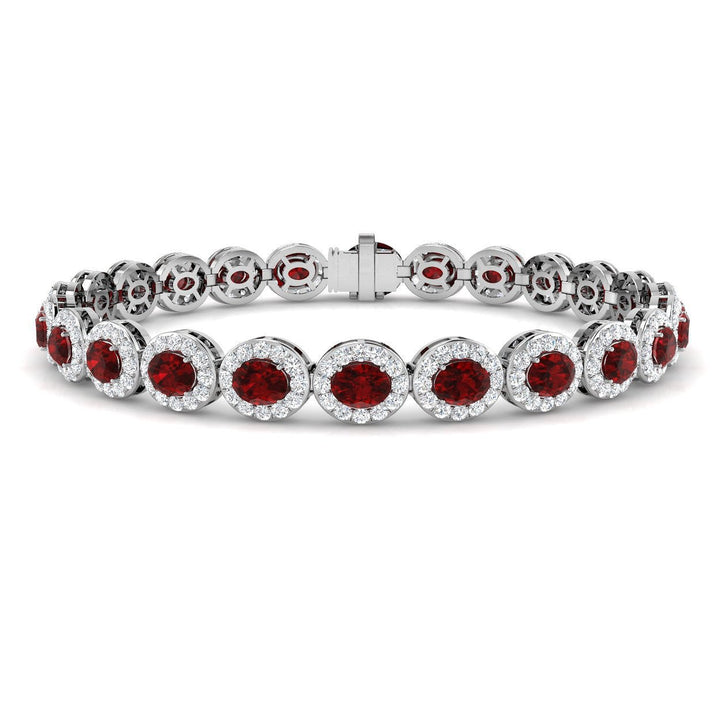
Bracelets and necklaces
Typically made with filigree platinum and embellished with pearls, these pieces exude luxury and class. They are ideal for high-society gatherings, subtly showcasing one's refined taste.
With its variety and intricate designs, Edwardian jewellery remains a timeless choice for those seeking to add a touch of historical elegance to their collection.
Jewellery for Daywear vs. Evening Wear: Edwardian Elegance
When considering the versatility of Edwardian jewellery, it's evident that pieces were purposefully crafted to suit different social occasions, distinguishing between daywear and evening wear.
Daywear Elegance
Simpler designs with smaller gemstones and lighter metalwork were typical of daytime jewellery. Pearls and delicate diamonds were common choices, reflecting the social norms of subtlety and refinement during the day. Such pieces complemented daytime attire gracefully, enhancing the wearer's appearance without being overly ornate.
Evening Opulence
In contrast, evening jewellery embraced a more opulent style. These pieces often included bold gemstones like sapphires and emeralds, set in intricate filigree that caught the light beautifully. The elaborate designs were in line with evening etiquette, which celebrated extravagance at social events.
This distinction in jewellery styles highlights the Edwardian commitment to appropriate adornment for every occasion.
The role of jewellery in social events and ceremonies
Jewellery held significant importance in Edwardian social events and ceremonies, functioning both as a fashion accessory and a symbol of social rank and wealth. Key aspects of its utilisation include:
1. Formal Events: On occasions like balls and operas, women often wore elaborate diamond tiaras and necklaces. These pieces showcased their wealth and highlighted their prominent role within society.
2. Daytime Gatherings: For events such as garden parties, brooches and pearl-adorned hair combs were popular. These items allowed individuals to express their personal style and keep up with fashion trends.
3. Weddings and Christenings: Sentimental jewellery like engraved bracelets and lockets were favoured during these ceremonies. Such pieces symbolised familial bonds and heritage, adding a deeper emotional value to the occasion.
4. Matching with Attire: Selecting jewellery to complement one's clothing was a way to display good taste and a keen understanding of social etiquette, thereby reinforcing one's social standing.
Iconic Edwardian Jewellery Pieces and Designers

During the Edwardian period, jewellery design reached new heights of sophistication and elegance. This era saw the emergence of renowned designers and creations that have become timeless symbols of luxury. Esteemed houses such as Cartier, Tiffany & Co., and Fabergé played a significant role in shaping the jewellery trends of the time. Their intricate designs, often featuring pearls and diamonds, showcased a blend of opulence and delicate craftsmanship that continues to influence modern jewellery.
The Edwardian era, spanning roughly from 1901 to 1910, was defined by a focus on lightness and femininity in jewellery. Cartier, for example, gained fame for its use of platinum, allowing for more intricate and airy designs than the heavier gold pieces of previous eras. Tiffany & Co., on the other hand, was renowned for its innovative use of coloured gemstones and exceptional quality. Fabergé introduced a distinctive Russian touch to the Edwardian style with his famous eggs and intricate enamel work.
These designers were not simply making jewellery; they were creating pieces of art that told a story and reflected the societal changes of the time. The elegance and sophistication of Edwardian jewellery remain a source of inspiration, embodying a perfect balance of beauty and craftsmanship that continues to be revered today.
Quote: 'The Edwardian era was a golden age of jewellery design, where elegance and artistry combined to create timeless pieces that still enchant us today.'
Highlighting famous Edwardian jewellery pieces and their stories
Among the most celebrated Edwardian jewellery pieces is the Cullinan Diamond, intricately cut and incorporated into the British Crown Jewels. The period's iconic designs, historical significance, and cultural impact resonate with collectors and enthusiasts, inviting them to be part of a rich heritage.
1. Cartier's Garland Style Tiara (1902) - Emblematic of Edwardian elegance, crafted for Queen Mary, showcasing the era's affinity for luxurious and ornate designs.
2. Fabergé Imperial Easter Eggs - These masterpieces symbolise the zenith of Edwardian craftsmanship, intertwining art with royal patronage.
3. Ladies of Devonshire Parure by Boucheron - A reflection of sophisticated taste, blending diamonds, pearls, and emeralds in exquisite harmony.
4. La Peregrina Pearl Necklace - Worn by icons like Elizabeth Taylor, this piece epitomises the timeless allure of Edwardian jewellery.
Let's explore the stories behind some of the most famous Edwardian jewellery, pieces that have left an indelible mark on history and continue to enchant modern collectors.
€4.183,95
El atractivo atemporal de este elegante brazalete de diamantes y zafiros azules lo convierte en una adición bienvenida a cualquier colección de joyas. Los zafiros azules brillantes agregan una sensación lujosa al diseño. El oro blanco mantendrá su brillo brillante… read moreBrazalete de zafiro azul de 1,10 quilates y diamantes G/SI de 0,85 quilates en oro blanco de 18 k

The Cullinan diamond
The Cullinan Diamond, discovered in South Africa in 1905, is the largest gem-quality rough diamond ever found. Weighing an astonishing 3,106 carats, it was presented to King Edward VII and subsequently cut into several stones by Asscher Brothers of Amsterdam. The largest of these, Cullinan I, also known as the Great Star of Africa, is set in the Sovereign's Sceptre with Cross, while Cullinan II, the Second Star of Africa, adorns the Imperial State Crown. These jewels are central to the British Crown Jewels and represent the pinnacle of royal opulence.
Cartier's Garland Style Tiara (1902)
Created for Queen Mary, the Garland Style Tiara by Cartier is a quintessential example of Edwardian jewellery design. The tiara's intricate latticework and use of diamonds and platinum exemplify the era's preference for delicate, lacy structures that exude elegance and sophistication. This piece not only highlights Cartier's technical prowess but also reflects the societal and cultural emphasis on refinement during the Edwardian period.
Fabergé Imperial Easter Eggs
The pinnacle of luxury and artistry are Fabergé's Imperial Easter Eggs, which the Russian Tsars Alexander III and Nicholas II commissioned as Easter gifts for their wives and mothers. Each egg is a masterpiece, featuring intricate designs and often containing hidden surprises, such as miniature portraits, mechanical birds, or tiny carriages. These eggs are a testament to the exquisite craftsmanship and creativity of Peter Carl Fabergé and his workshop, making them highly sought-after by collectors worldwide.
Ladies of Devonshire Parure by Boucheron
A tiara, necklace, earrings, and bracelet are all part of the stunning Ladies of Devonshire Parure jewellery collection by Boucheron. This parure showcases a harmonious blend of diamonds, pearls, and emeralds, creating a cohesive and elegant look. The 6th Duke of Devonshire commissioned the piece as a gift for his wife, and it remains a symbol of sophisticated taste and the opulence of the Edwardian era.
La Peregrina Pearl Necklace
La Peregrina, one of the most famous pearls in the world, has a storied history that dates back over 500 years. Before Richard Burton purchased it for Elizabeth Taylor in 1969, it belonged to European royalty, including Queen Mary I of England. Taylor's love for jewellery and her impeccable style brought this exquisite pearl necklace back into the limelight. The necklace, which Cartier created, embodies the timeless allure and elegance associated with Edwardian jewellery. It has diamonds, rubies, and pearls.
These remarkable pieces showcase the Edwardian era's exceptional craftsmanship and tell fascinating stories of royalty, luxury, and enduring beauty. The intricate designs and rich history of Edwardian jewellery continue to enthrall collectors and enthusiasts, preserving these works of art for future generations.
€643,95
Este anillo de la eternidad tiene una belleza elegante y atemporal. Este anillo, elaborado a mano en oro blanco inmaculado de 18k, presenta un círculo completo de diamantes negros naturales de talla redonda de calidad G/SI con un peso total… read moreAnillo de eternidad con diamante negro de 0,35 quilates y 50 piedras en oro blanco de 18 k
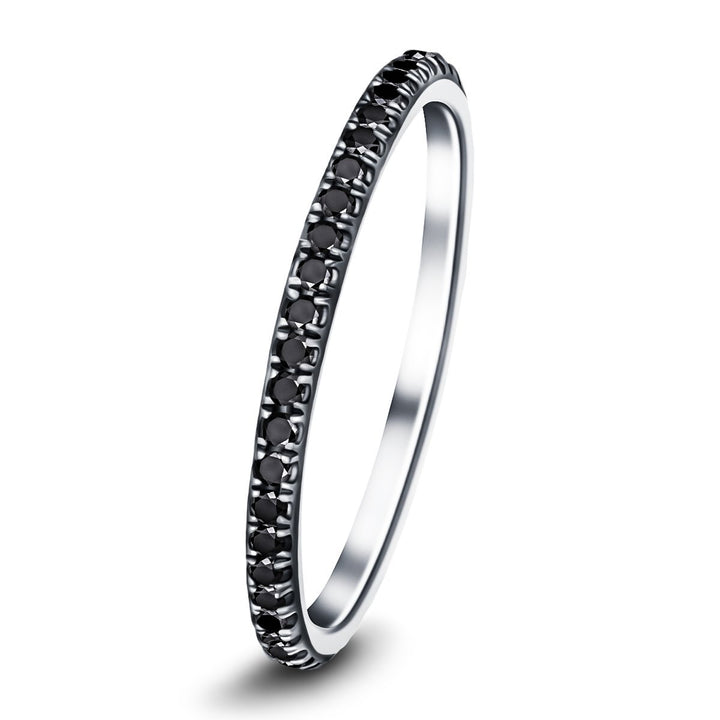
Prominent Jewellery Designers and Houses of the Edwardian Era
Renowned for their creative use of materials and exquisite craftsmanship, designers such as Cartier, Fabergé, and Tiffany & Co. dominated the Edwardian period with iconic jewellery pieces that continue to influence modern fashion.
These designers left significant marks on the world of fine jewellery, each with a distinct style that exudes elegance and sophistication. Their legacies are built on artistic inspirations drawn from nature and classical motifs, which they transformed into intricate designs featuring platinum and vibrant gemstones.
This era of creativity fostered a sense of belonging among those who adored their work, ensuring that the allure of Edwardian jewellery remains timeless. Collectors and fashion enthusiasts alike cherish it for its unparalleled grace and charm.
Contributions of Cartier, Tiffany & Co., and Fabergé
Several esteemed designers significantly influenced Edwardian jewellery with their imaginative designs and exceptional craftsmanship. Cartier, Tiffany & Co., and Fabergé were among these influential designers. Their creations mirrored the opulence of the era and played a pivotal role in the evolution and historical significance of jewellery design.
Cartier was famous for serving royalty. Their pieces showcased intricate filigree and platinum settings, epitomising the elegance of the period.
Tiffany & Co. was known for their emphasis on elegance. Their designs featured high-quality diamonds, enhancing their timeless appeal.
Fabergé was celebrated for their meticulous craftsmanship. Their jewellery often incorporated luxurious gemstones and elaborate motifs, attracting an elite clientele.
Artistic Influences: Each of these houses integrated classical motifs and geometric patterns into their work, demonstrating their artistic skill and shaping contemporary views of luxury and beauty.
The Legacy of Edwardian Jewellery

The Timeless Allure of Edwardian Jewellery
Edwardian jewellery still captivates audiences today, showcasing its enduring charm and influence on current fashion and design.
Collectors and enthusiasts who value their historical significance and meticulous craftsmanship highly prize these items.
Contemporary jewellery designers also take cues from Edwardian designs and methods, infusing them into their own pieces to merge classic sophistication with modern styles.
The lasting popularity of Edwardian jewellery in contemporary times
Edwardian jewellery continues to be highly sought-after and celebrated for its detailed craftsmanship and timeless elegance. Its ongoing popularity in today's society is due to several key factors:
Modern Adaptations
Innovative Designs: Contemporary jewellers often incorporate Edwardian motifs into their collections, making these designs relevant to today's fashion trends and popular among celebrities.
Collectors' Favourites
Historical Appeal: The unique charm and historical significance of Edwardian pieces make them highly prized among collectors, increasing their investment value. As one collector put it, 'Owning an Edwardian piece is like holding a piece of history.'
Versatile Styling
Fashion Flexibility: Edwardian jewellery offers versatile styling options, seamlessly blending with both vintage and modern outfits. Fashion magazines frequently feature these pieces in editorials, showcasing their adaptability.
€972,95
Agregar descripción… read moreAnillo de compromiso con zafiro verde pera y diamantes, oro amarillo de 18 quilates y 1,50 quilates

Accessibility through online marketplaces
Ease of Acquisition: The rise of online marketplaces has made it easier for enthusiasts to purchase these antique treasures and access essential jewellery care tips. This accessibility has widened the audience for Edwardian pieces, making them more popular than ever.
The lasting appeal of Edwardian jewellery lies not only in its beauty but also in its ability to adapt to contemporary tastes while retaining its historical allure.
The Edwardian influence on contemporary jewellery designs
Contemporary jewellery often reflects the intricate details and feminine themes that were hallmarks of the Edwardian era. This period's aesthetic has a lasting impact, as modern designers appreciate the light, airy qualities that define Edwardian craftsmanship.
Innovations in materials, particularly the use of platinum, echo the historical move towards more refined and durable elements, adding both beauty and longevity to today's pieces.
Today's fashion trends also see a revival of symbolic motifs such as bows, garlands, and stars. While imbued with new meanings, these designs still hold the timeless elegance of Edwardian styles.
Although modern techniques have advanced, the meticulous attention to detail and filigree work from the Edwardian period continue to set a high standard. These practices inspire contemporary jewellers to blend classic elegance with modern aesthetics in their creations.
Final Thoughts on Edwardian Jewellery

As we conclude our examination of Edwardian jewellery, it is evident that its distinctive elegance and meticulous craftsmanship have cemented its position in art and history.
These pieces demonstrate the technological progress of the early 20th century and mirror the era's emphasis on refinement and femininity.
We urge enthusiasts and collectors to admire the fragile beauty and historical importance of Edwardian jewellery.
A recap of the elegance and key characteristics of Edwardian jewellery
Edwardian jewellery epitomises elegance through its delicate, lace-like patterns and skilful use of platinum. Pieces from this era are known for their meticulous attention to detail, timeless sophistication, and refined femininity, appealing to those who appreciate historical continuity and sophistication in their jewellery.
Intricate Designs: Techniques such as millegrain and filigree were used to create intricate, delicate patterns.
Timeless Elegance: The frequent incorporation of platinum and diamonds gives these pieces a lasting sense of style.
Feminine Sophistication: Motifs like bows, garlands, and floral patterns introduce an element of grace and beauty.
Exquisite Materials: Pearls and platinum, commonly found in Edwardian jewellery, symbolise the era's luxurious taste.
Each piece, featuring nature-inspired motifs or classical geometric shapes, offers a glimpse into the cultural narratives of early 20th-century society. These ornamental works not only have aesthetic appeal but also capture the social mores and artistic preferences of a time of grace and artistic advancement.
They establish a link to the past that remains relevant even today.
€1.584,95
La tanzanita exótica y más de medio quilate de diamante clásico se combinan para formar un estallido de luz en esta pieza maravillosamente hecha a mano. Fabricado en oro blanco de 18 quilates por nuestros artesanos del Reino Unido, será… read moreCollar de diamantes G/SI de 1,30 ct y 0,60 ct de tanzanita en oro blanco de 18 k

Explore and Appreciate the Beauty of Edwardian Jewellery For Yourself
Appreciating the delicate intricacies of Edwardian jewellery can deepen one's admiration for both historical craftsmanship and the artistic elegance of the period. As you immerse yourself in these precious artefacts, consider the following aspects to enrich your sense of style and historical charm:
1. Subtle Elegance: Notice the refined beauty of lacy platinum settings and the shimmer of high-quality diamonds and pearls, which reflect the period's sophisticated tastes.
2. Artistic Charm: Consider classical motifs like bows and garlands, which embody the artistic spirit of the Edwardian era.
3. Design Appreciation: Marvel at the intricate designs symbolising femininity and meticulous attention to detail.
4. Craftsmanship Excellence: Acknowledge the advanced techniques used to create the light, airy structures that continue to enchant collectors and fashion enthusiasts today.
Edwardian jewellery remains a testament to a period of unparalleled elegance and innovation, particularly with the introduction of platinum.
This era marked a pinnacle in jewellery craftsmanship, creating pieces that combined intricate designs with dazzling diamonds.
The enduring allure of Edwardian jewellery continues to inspire contemporary designs, reflecting its timeless beauty and exceptional artistry.
Discover the timeless elegance of vintage-inspired jewellery for yourself by exploring the exquisite collections at All Diamond. Each piece of real diamond jewellery is meticulously designed and handcrafted in the UK, ensuring a legacy of beauty and quality that lasts a lifetime.
Visit our online store today and experience the sophistication of a heritage of generations of designers and artisans with the assurance of our lifetime workmanship guarantee. Elevate your style and create your own history!


